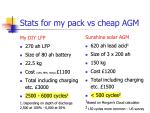geem
Well-Known Member
Agreed but you can also do the same with lead in an emergency.The difference with using a smaller range of charge with LFP is that you always have the choice of using the whole range. Looking forward to hearing about your build.
I know people on here will tell you how cheap lifepo4 is but it isn't really. I am buying cells from the USA. £1000 for eight 280Ah. Class T fuse and holder. £150. Victron b2b £250. Carriage for the cells £150. There will be sundry parts such as new tinned wire, terminals, threaded rod, end plates etc but we are already up to £1550. To replace my Trojans with no other costs would be £750 out here. Cheaper in the UK.
I will be keeping the Trojans until they fail, which might be a long way off. They are four years old this year and still test perfectly on the hydrometer even though they suffer high temperatures.
Edit; forgot to add in BMS at £150 as well.



